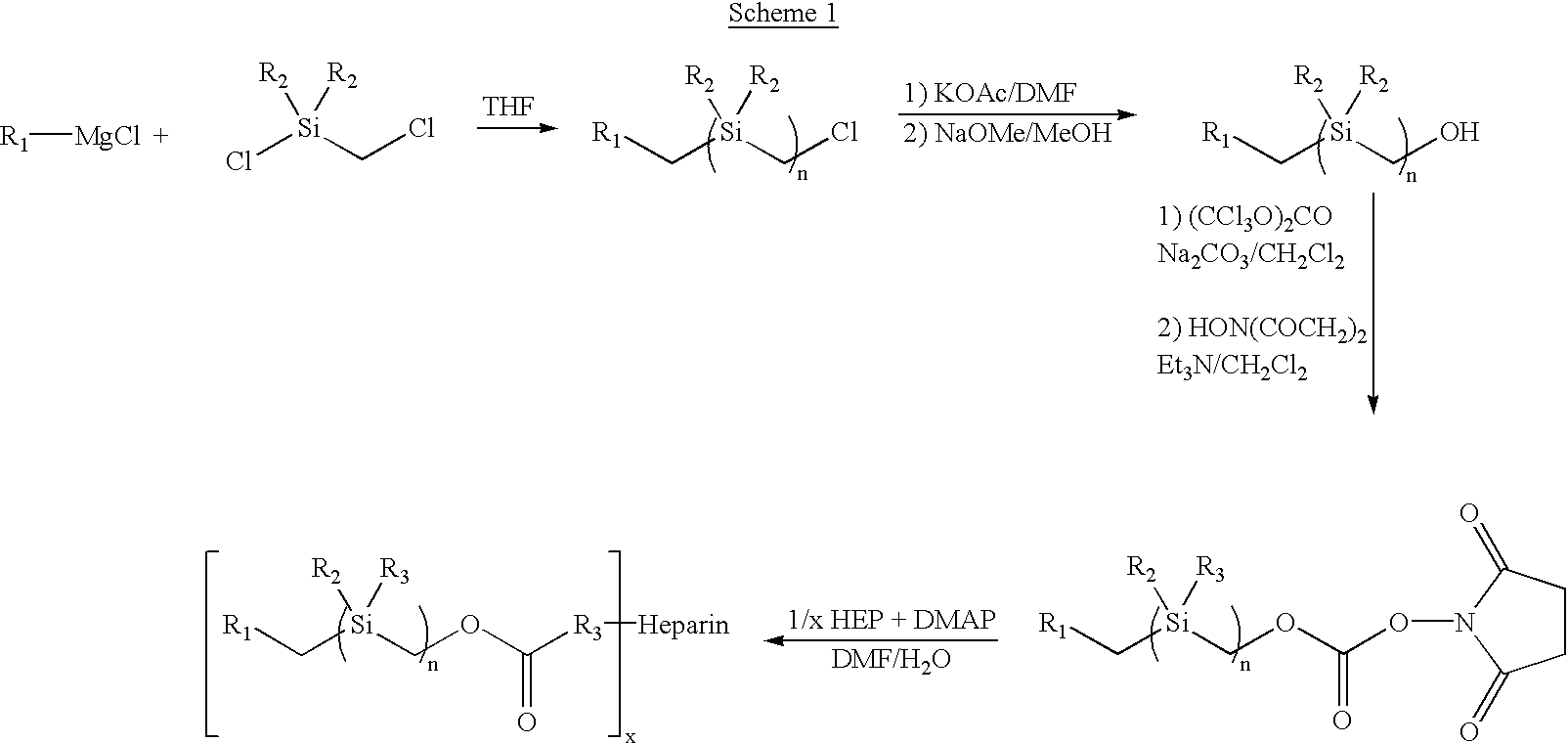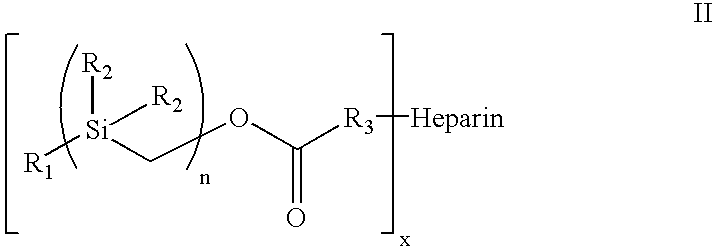Nucleic acid coating compositions and methods
a technology of nucleic acid and composition, applied in the field of coatings and methods, can solve the problems of requiring a substantially greater amount of gene constructs, affecting the effect of gene transfection, and requiring significant limitations, and achieve the effect of promoting the desired biological or therapeutic
- Summary
- Abstract
- Description
- Claims
- Application Information
AI Technical Summary
Benefits of technology
Problems solved by technology
Method used
Image
Examples
embodiment 12
[0057] Heparin comprises many repeating units containing amine and hydroxyl functional groups which can be the site for attachment of the hydrophobic silyl moiety to the heparin molecule. Accordingly, one embodiment of the present invention contemplates the attachment of more than 1 hydrophobic silyl moiety to a single heparin molecule. As many as 30 or more hydrophobic silyl moieties of Formula I, and as few as 1 hydrophobic silyl moiety, may be attached to a single heparin molecule to achieve the covalent complex employed in the heparin coating compositions of the present invention. In one embodiment of the present invention, between 2 and 25 hydrophobic silyl moieties are attached to a single heparin molecule. In another embodiment, between 5 and 20 hydrophobic silyl moieties are attached to a single heparin molecule. In another embodiment, between 7 and 15 hydrophobic silyl moieties are attached to a single heparin molecule. In a preferred embodiment, 7 or 8 hydrophobic silyl mo...
example 1
Method for Preparing Silyl-Heparin Covalent Complexes
[0090] Treatment of benzylmagnesium chloride 1 with chloro(chloromethyl)dimethysilane 2 gave benzyl(chloromethyl)dimethysilan-e 3 (n=1), all as shown in Scheme 2 below. Treatment of 3.sub.n with magnesium gave the Grignard Reagent, which was treated with chloro(chloromethyl)di-methyl-silane again to give the homologous silyl compound 3.sub.n+1. The Grignard reaction can be repeated over and over again to obtain the desired chain-length for the silyl compound. The chloro-silyl compound 3, on treatment with potassium acetate, followed by trans-esterification of the corresponding acetate with basified methanol gave the alcohol 4. The alcohol 4, when treated with triphosgene gave the corresponding chloroformate, which on treatment with N-hydroxy-succinimide gave the N-hydroxy-succinimidyl-carbonate 5. The conjugation of heparin with 5 was achieved by treatment of heparin with 5 and 4-(dimethylamino)pyridine in 1:1 DMF / H.sub.2O to give...
example 2
Techniques for Applying Silyl-Heparin Coating Compositions to Surfaces.
[0097] The silyl-heparin complex of Example 1 was used as a coating solution as a 1% solution (w / v) in 60% aqueous ethanol. Materials were coated with silyl-heparin for 15 minutes at 370.degree. C. The coated materials were then were rinsed extensively in water, air-dried, and stored until use.
[0098] In another embodiment, the silyl-heparin complex was dissolved in distilled water with gentle stirring, and an organic solvent added, such as isopropyl alcohol or acetonitrile, such that the organic solvent constituted approximately 2 / 3 of the volume, such as 100 mg of silyi-heparin complex of Example 1 solubilized in 27 mL of distilled water with gentle stirring, with 53 mL of isopropyl alcohol or acetonitrile then added, providing a resulting concentration of the silyl-heparin complex in solution of about 0.125%. In other embodiments, the resulting solution had a silyl-heparin complex concentration of between 0.01 ...
PUM
| Property | Measurement | Unit |
|---|---|---|
| Composition | aaaaa | aaaaa |
| Hydrophobicity | aaaaa | aaaaa |
| Interaction | aaaaa | aaaaa |
Abstract
Description
Claims
Application Information
 Login to View More
Login to View More - R&D
- Intellectual Property
- Life Sciences
- Materials
- Tech Scout
- Unparalleled Data Quality
- Higher Quality Content
- 60% Fewer Hallucinations
Browse by: Latest US Patents, China's latest patents, Technical Efficacy Thesaurus, Application Domain, Technology Topic, Popular Technical Reports.
© 2025 PatSnap. All rights reserved.Legal|Privacy policy|Modern Slavery Act Transparency Statement|Sitemap|About US| Contact US: help@patsnap.com



